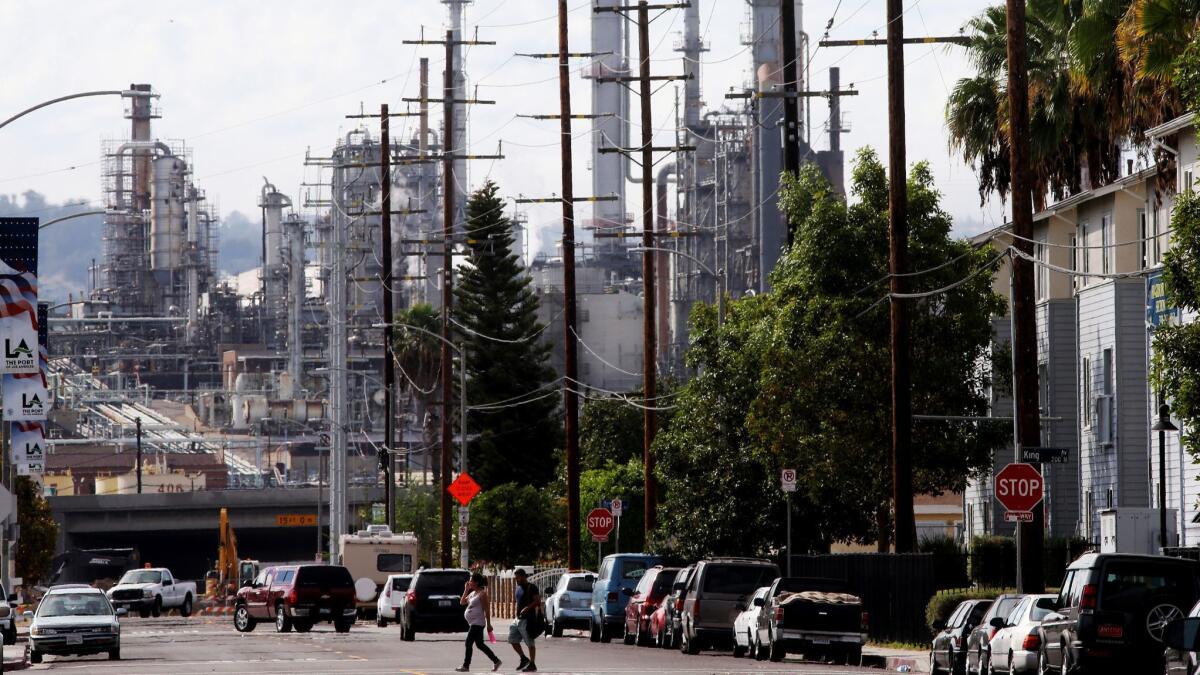California counters Trump on car emissions standards, expands other climate rules

In an escalation in the fight against climate change and the Trump administration, California regulators approved new measures to defend the state’s vehicle emissions standards and bolster rules to cut carbon pollution from transportation.
The state Air Resources Board voted Friday to require automakers to comply with California’s strict rules on car and truck pollution if they want to sell vehicles in the state. It’s California’s latest move against the Trump administration’s plan to freeze fuel economy targets and revoke California’s power to set its own standards. State officials said the counterstrike was necessary to close a potential loophole automakers could use to evade compliance with California’s more stringent rules.
“The health of our state, our nation and the globe are at stake, and that is a fight worth having,” said state Sen. Ricardo Lara (D-Bell Gardens), who sits on the board.
The measure seeks to strengthen California’s footing as it fights to preserve its emissions rules, both in court and in negotiations with the White House. At the same time, the move brings the nation one step closer to having two different standards: One for California and the dozen other aligned states that account for one-third of the U.S. auto market, and another for the rest of the country.
During the board’s meeting in Sacramento, the 16-member panel also expanded a climate rule that reduces carbon pollution with tradeable credits that gasoline and diesel producers must purchase from producers of lower-carbon fuels, such as hydrogen and biodiesel. By further incentivizing those cleaner technologies, the low-carbon fuel standard is expected to cut the cost of a new electric vehicle by up to $2,000 while raising gas prices by up to 36 cents over the next 12 years.
The market-based program, first adopted in 2009, aims to cut greenhouse gas emissions by spurring technology advancements that reduce the carbon intensity of transportation fuels. The state imposes a gradually declining cap on carbon intensity from “well to wheel,” including oil extraction, fuel production and distribution. Companies that produce gasoline, diesel and other fuels must meet those carbon-reduction targets each year, either directly or by purchasing credits from clean-fuel producers that exceed those standards.
In extending its low-carbon fuel standard, the state will require a 20% cut in the carbon intensity of transportation fuels by 2030, compared with a 10% reduction by 2020 under the current mandate.
“These amendments will take California’s climate fight up another notch,” air board chair Mary Nichols said.
Taken together, the actions show some of the ways California can forge ahead fighting global warming in spite of the Trump administration’s moves to dismantle climate regulations. Much bolder actions will be needed to slash greenhouse gases to meet state targets, including the latest ambitious goal Gov. Jerry Brown issued in an executive order earlier this month: making California’s entire economy carbon neutral by 2045.
The transportation sector remains the biggest obstacle to California meeting its climate goals. Pollution from cars and trucks, already the state’s largest source of greenhouse gas emissions, has been rising the last few years as a result of more driving and the popularity of bigger, less-fuel-efficient SUVs.
The vehicle emissions standards the state is fighting to preserve would boost fuel economy of cars and trucks to about 36 miles per gallon in real-world driving by 2025, while the Trump administration proposal freezes it at the 2020 level of about 30 mpg.
The federal proposal would result in 12 millions of tons of excess greenhouse gas emissions by 2030 in California, both from vehicle tailpipes and from refineries as a result of increased gas consumption, according to an air board analysis. That additional pollution would wipe out any benefits from the strengthened low-carbon fuel standards approved Thursday, the board projected.
Automakers asked the Trump administration early on to relax emissions rules, but now say they don’t want the market split into two, requiring them to build different models of cars. Auto industry representatives on Friday urged the Air Resources Board to hold off on the measure and try to reach a compromise with the federal government.
California officials dismissed that idea, but said they’ve continued negotiations with the Trump administration. After a meeting last month, the White House, federal officials and the California Air Resources Board issued a joint statement agreeing to future meetings “with the shared goal of achieving one national set of standards for vehicle fuel economy and greenhouse gas emissions.”
The low-carbon fuel standard reauthorized this week is one of the lesser-known pillars of California climate policy and is crucial for the state to meet its ambitious target of slashing greenhouse gas emissions 40% below 1990 levels by 2030.
Some of the changes to the program approved Friday were designed to stimulate sales of zero-emission vehicles and the installation of electric charging and hydrogen fueling stations. Electric vehicles account for about 6% of vehicles sold in California, and that must ramp up dramatically if California is to meet its climate goals.
One notable provision directs utilities to use low-carbon fuel credits to offer increased rebates at car dealerships at the time of purchase, rather than by reimbursement after the fact.
Customers would be offered an upfront rebate of up to $2,000 on the purchase of a zero-emission vehicle. The statewide program, being developed by utilities and automakers, could begin as soon as 2019.
“This is money on the hood that can go to driving down the purchase price,” said Will Barrett, director of clean air advocacy for the American Lung Assn. in California. “It gives people a real tangible, on-the-spot incentive to make the clean-air choice.”
The auto industry says more generous rebates are needed because several car manufacturers are close to running out of federal tax credits of up to $7,500 per electric vehicle.
The fuel standard won’t get California to its pollution-reduction targets on its own, but is an important part of state officials’ three-pronged approach to reducing transportation emissions by shifting to cleaner fuels, slashing tailpipe emissions and reducing driving through transit-oriented development.
As part of the expansion of the program, the air board also established new protocols for generating credits through carbon capture and sequestration projects that collect emissions before they spew into the atmosphere and injects them underground. Those adjustments reflect a growing recognition by experts and regulators that sequestration will be essential to keeping global temperatures from rising no more than 2 degrees Celsius and avoiding the most devastating consequences of climate change.
The expansion of the low-carbon fuels program was greeted enthusiastically by biofuel producers and other renewable energy interests who benefit from the credit-based program and say it will help continue the shift toward cleaner technology.
The oil industry, the main target of the rules, has warned of increased costs that will be passed on to consumers in the form of higher gas prices.
Air Resources Board spokesman Dave Clegern said the low-carbon fuel standard is just one part of a portfolio of state greenhouse gas reduction policies that “has the potential to save individual California households money, as efficiency-related actions that reduce the amount of fuel used offset the somewhat higher costs of some low-carbon fuels today.”
During the two-day meeting, the state air board also approved a list of 10 communities hard hit by health-damaging air pollution from freeways, ports, warehouses, rail yards, oil wells, refineries and other industry that will be targeted for air monitoring, emissions reductions or both. The move by the board’s newly established Community Air Protection Program is required under legislation aimed at addressing criticism by environmental justice groups that the state’s climate policies do not bring benefits to the state’s worst-polluted communities.
Gladys Limón, executive director of the California Environmental Justice Alliance, said that by approving the plan the state “has taken some important first steps toward its legal mandate and moral duties to ensure that all California residents have clean, healthy air” but added that “much remains to be done, including adoption of enforceable reduction measures.”
The neighborhoods, narrowed down from a list of hundreds suggested by community groups and air quality officials, will be the first selected for local air quality improvements under a law signed last year by Brown as part of the deal to extend the cap-and-trade program for cutting greenhouse gases.
The selected communities are:
Southern California
- Boyle Heights, Commerce, East Los Angeles
- San Bernardino, Muscoy
- Wilmington, West Long Beach, Carson
Bay Area
- Richmond
- West Oakland
San Joaquin Valley
- Shafter
- South Central Fresno
Imperial Valley
- Calexico, El Centro, Heber
San Diego
- Barrio Logan, West National City, Logan Heights, Sherman Heights
Sacramento
- South Sacramento-Florin
More to Read
Sign up for Essential California
The most important California stories and recommendations in your inbox every morning.
You may occasionally receive promotional content from the Los Angeles Times.











